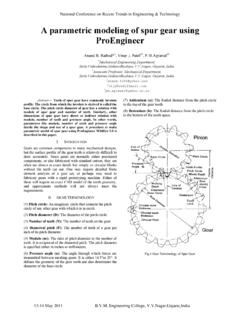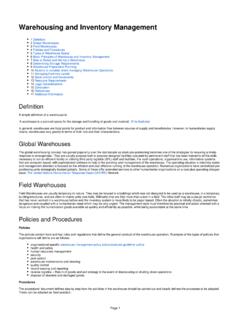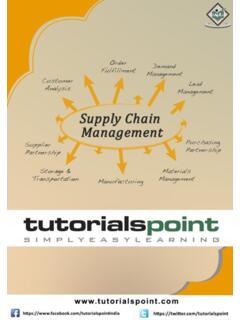Transcription of CONSTRUCTION MATERIALS MANAGEMENT ON PROJECT …
1 CONSTRUCTION MATERIALS MANAGEMENT ON PROJECT SITESK hyomesh V. Patel (PG Student) Prof. Chetna M. Vyas ( Cont.)Master of Engineering in CONSTRUCTION Eng. & MANAGEMENT Department of Civil EngineeringBirla Vishvakarma Mahavidyalaya Institute Of TechnologyVallabh Vidhyanagar ,Gujarat, India New Vallabh Vidhyanagar ,Gujarat, IndiaE-mail: Abstract -This paper is written to fill a void created by the absence of proper MATERIALS MANAGEMENT on CONSTRUCTION sites. To managing a productive and cost efficient site efficient material MANAGEMENT isvery hasshown that CONSTRUCTION MATERIALS and equipment may constitute more than 70% of the total cost for a typical CONSTRUCTION PROJECT . Therefore the proper MANAGEMENT of this single largest component can improve the productivity and cost efficiency of a PROJECT and help ensure its timely completion.
2 One of the major problems in delaying CONSTRUCTION projects is poor MATERIALS and equipment MANAGEMENT . This paper describes the main results of survey carried out in Ahmedabad that investigated the material MANAGEMENT of 3 well-known builders of WORDS: CONSTRUCTION MATERIALS , Cost control, MATERIALS ManagementINTRODUCTIONM aterials MANAGEMENT is a process for planning, executing and controlling field and office activities in goal of MATERIALS MANAGEMENT is to insure that CONSTRUCTION MATERIALS are available at their point of use when needed. The MATERIALS MANAGEMENT system attempts to insure that the right quality and quantity of MATERIALS are appropriately selected, purchased, delivered and handled on site in a timely manner and at a reasonable cost. MATERIALS MANAGEMENT is the system for planning and controlling all of the efforts necessary to ensure that the correct quality and quantity of MATERIALS are properly specified in a timely manner, are obtained at a reasonable cost and most importantly are available at the point of use when MATERIALS MANAGEMENT is an important element in PROJECT MANAGEMENT .
3 MATERIALS represent a major expense in CONSTRUCTION , so minimizing procurement costs improves opportunities for reducing the overall PROJECT costs. Poor MATERIALS MANAGEMENT can result in increased costs during CONSTRUCTION . Efficient MANAGEMENT of MATERIALS can result in substantial savings in PROJECT costs. If MATERIALS are purchased too early, capital may be held up and interest charges incurred on the excess inventory of MATERIALS . MATERIALS may deteriorate during storage or get stolen unless special care is taken. Delays and extras expenses may be incurred if MATERIALS required for particular activities are unavailable. Ensuring a timely flow of MATERIALS is an important concern of material effectively managing and controlling MATERIALS , the performance of MATERIALS MANAGEMENT should be measured. A performance measure calculates the effective working of a function.
4 These performance measures may differ from system to system. The measures divide the MATERIALS MANAGEMENT system in parts and make the working of the system more efficient. When joined, the measures make the complete MATERIALS MANAGEMENT REVIEWM aterial MANAGEMENT can be defined as a process that coordinates planning, assessing the requirement, sourcing, purchasing, transporting, storing and controlling of MATERIALS , minimizing the wastage and optimizing the profitability by reducing cost of material . Building MATERIALS account for 60 to 70 percent of direct cost of a PROJECT or a facility, the remaining 30 to 40 percent being the labour of material MANAGEMENT are: material estimation, budgeting, planning and programming. Scheduling , purchasing and procurement Receiving and inspection. inventory control, storage and warehousing material handling and transport Waste management13-14 May 2011 Engineering College, ,Gujarat,IndiaNational Conference on Recent Trends in Engineering & Process of material ManagementOBJECTIVES OF MATERIALS MANAGEMENT Efficient MATERIALS planning Buying or Purchasing Procuring and receiving Storing and inventory control Supply and distribution of MATERIALS Quality assurance Good supplier and customer relationship Improved departmental efficiencyTo fulfill all these objectives, it is necessary to establish harmony and good co-ordination between all the employees of material MANAGEMENT department and this department should have good co-ordination with the other departments of the organization to serve all production OF MATERIALS MANAGEMENTThe functions of MATERIALS MANAGEMENT are discussed below.
5 In order to fulfill the objectives of MATERIALS MANAGEMENT as stated above to meet the basic objectives and goals, the functions of the MATERIALS MANAGEMENT are also categorized as primary and secondary functions.(I) Primary FunctionsTo meet the primary objectives, the primary functions of the MATERIALS MANAGEMENT are given as follows: MATERIALS Requirements Planning (MRP) Purchasing inventory Planning and Control Ascertaining and Maintaining the Flow and Supply of MATERIALS Quality Control of MATERIALS Departmental Efficiency(II) Secondary Functions Standardization and Simplification Make and Buy Decisions Coding and Classification of MATERIALS Forecasting and PlanningPROJECT MANAGEMENTS pecial training sessions should be arranged on site to update the workers regarding the latest techniques. Plant and machinery should be updated regularly in order to avoid any break down. Workers and contractors should be guided for correct methodology to execute a particular task.
6 Regular check should be kept on planning so as to overcome any error. Proper supervision should be done on site to improve the level of workmanship. Taylor (1913) pointed out that the economic losses caused by material waste are smaller than those related to the inefficiency of human work. Ford (1927) also suggested that human work should be the focus of waste convention since the value of MATERIALS depends, to a great extent, on the work that has been spent on them. Berliner B. says PROJECT control in many companies is based mostly on financial performance measures, which tend to be backward focused and do not make it easy to trace operational PROCESSESA ccording to Agarwal Anil (NICMAR, Pune) benchmarking processes and techniques can be applied to develop benchmarks for wastage control of building MATERIALS . After selection of PROJECT , the following steps are adopted.
7 Work out estimates of quantities of MATERIALS required either from the first or final drawings. From site records/ accounts records, actual quantities of material consumed is obtained. Interviews are held with PROJECT managers and owners concerned to collect other related most commonly used basis for planning things out for the PROJECT is the BOQ prepared by the client. Companies may have two major levels in planning- micro and macro level. Time, cost, material and labour are the four major types of planning undertaken on sites. The planning should be revised as frequently as possible in order to monitor whether work is progressing as to Ninad Shah and Manish Dave Purchasing procedure can be described as below:Step 1 material IndentStep 2 Enquiry to VendorsStep 3 Vendor ComparisonStep 4 Vendor Selection and NegotiationsStep 5 Purchase OrderStep 6 Vendor EvaluationRECEIVINGA ccording to Sundersan, M.
8 The receipt system can be divided into:13-14 May 2011 Engineering College, ,Gujarat,IndiaNational Conference on Recent Trends in Engineering & Technology1. Receipt from outside suppliers2. Receipts from internal divisions. System of receipt starts even before the material reaches the site. The three documents that should be dispatched are copy of purchase order, supplier s advice document and the consignment note. This enables the Stores manager to organize and plan for clearances of receipt from internal divisions, usually transfer notes and return to stores documents are Inspection can happen in two ways1. Pre- dispatch inspection2. Inspection on site It is the responsibility of the inspector to inspect all MATERIALS delivered to the site prior to their being used in the work. It is desirable to perform inspection of MATERIALS or fabricated products prior to their delivery at site.
9 : precast members. The inspector shall have rights to reject faulty material and have it removed from site. With respect to manufactured goods, the quality requirements should be specified in the purchase of InspectionThere are three methods of inspection:1. Visual 2. Tactile 3. Statistical STACKING AND STORAGET ypes of physical storage system on site vary according to the space availability and company practices. Industrial guidelines are also taken into consideration for the stacking and storage of particular MATERIALS . MATERIALS are most often classified as per the comfort level of working of the workers. Basic categories followed are civil, electrical, plumbing, finishes, CONSTRUCTION chemicals, miscellaneous. The MATERIALS are also often stacked as per the specification of the vendor or IS Codes (IS: 4082: recommendations on stacking and storage of CONSTRUCTION MATERIALS at site) specifications are also followed.
10 : As per IS : 4082,1. The MATERIALS should not be affected by impurities or atmospheric MATERIALS like cement should must be stored in covered sheds and stacked on timber raised Reinforcing bars should be stacked yards away from moisture to prevent rusting and also away from oil and lubricants. Bars of different classification, sizes and lengths should be stored separately to facilitate MATERIALA ccording to Sundersan, M. issues can be divided into1. Issues to consuming departments2. Issues to outside suppliers for processing or on site does not happen in the case of all CONSTRUCTION MATERIALS . In the case of sand or aggregate, the MATERIALS are consumed as and when required corresponding to the progress of the PROJECT . For other MATERIALS , issues are based on production programmes. Based on this and the bill of MATERIALS , work orders are printed, listing for each material , quantity to be issued against each component requiring that material .





